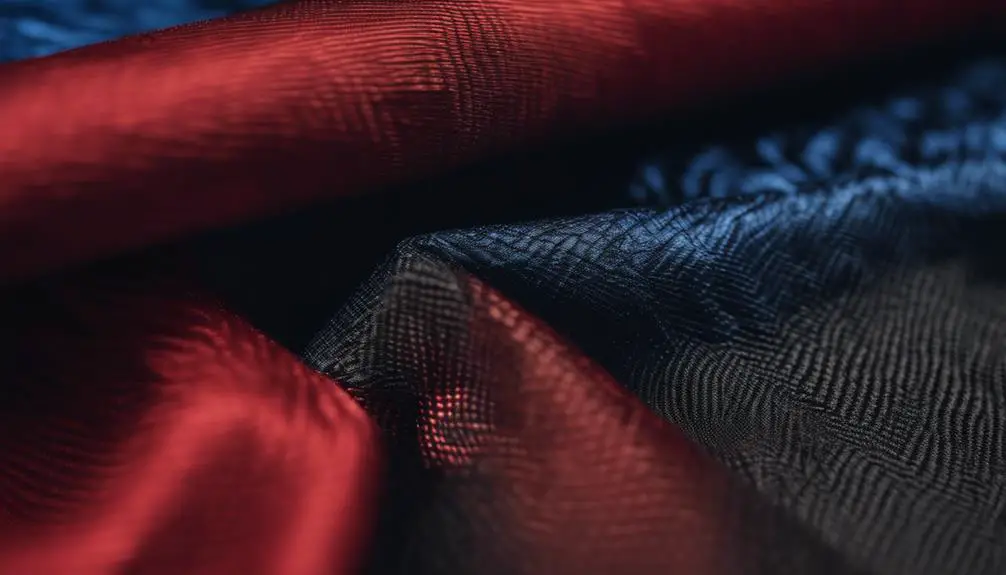To identify nylon, check for its shiny appearance and slippery feel. It's lightweight and drapes well, making it ideal for garments. Conduct a burn test by cutting a small sample. When ignited, nylon melts instead of burning quickly, giving off a distinctive celery-like smell and white smoke. It leaves behind hard, light brown ash. Be cautious with the test; verify you perform it in a safe area. With these steps, you can easily distinguish nylon from other fabrics. If you're curious about more identification methods, there's plenty more to explore regarding this versatile material.
Overview of Nylon Fabric

Nylon fabric is a remarkable synthetic material that stands out for its durability and strength. It's an excellent choice for various applications, from military uniforms to outdoor gear, thanks to its resistance to wear and environmental factors. The manufacturing process of nylon, introduced in the 1930s as a silk substitute, led to a fabric known for its high elasticity and quick-drying properties.
During a visual inspection, you'll notice nylon's bright luster and slippery feel, which set it apart from other materials like polyester. This unique texture, combined with its moisture-wicking properties, makes it a popular option for activewear and industrial uses. Nylon's resistance to mold, mildew, and chemicals further enhances its versatility, allowing it to perform well in demanding environments.
Identifying nylon accurately is essential, especially if you're considering it for specific projects. While the burn test will be covered later, understanding these characteristics will help you distinguish nylon from other fabrics. Knowing how to recognize nylon's strengths guarantees you make informed decisions when selecting materials for your needs.
Burn Test Procedure
To accurately identify nylon, conducting a burn test is a reliable method. Start by preparing a 1-inch sample of the fabric, removing any loose threads for the best results. Using a lighter or match, ignite the nylon sample and observe its behavior. You'll notice that nylon typically melts and shrinks away from the flame instead of igniting quickly.
As it burns, pay attention to the white smoke produced and the distinctive odor that resembles celery. These characteristics are key to distinguishing nylon from other fabrics. After the combustion, check the residue left behind; nylon will leave a hard, bead-like ash that's light brown and difficult to twist.
For the most accurate identification, it's important to conduct the burn test on multiple areas of the fabric. This way, you can confirm consistent results, which will strengthen your identification of the material. By following this burn test procedure, you can effectively differentiate nylon from other fibers, ensuring you know exactly what you're working with.
Appearance and Feel

When you examine nylon fabrics, their bright luster and slippery texture immediately stand out. You'll find that nylon generally has a lustrous appearance, which contributes to its appeal in various garments. The soft texture of nylon makes it incredibly comfortable against your skin, especially in activewear and lingerie.
Pay attention to these key characteristics when identifying nylon:
- High glossiness that gives it a shiny look
- Soft and lightweight feel compared to other materials
- Flexible and drapable nature, enhancing its versatility
- Duller color palette compared to brighter polyester fabrics
This visual distinction is significant; while nylon has that high glossiness, polyester often appears more vibrant with a slightly different sheen. You'll notice that nylon's flexibility allows it to move with you, making it an excellent choice for items where comfort is essential. Overall, the appearance and feel of nylon are what set it apart from other synthetic fabrics, making it ideal for a range of applications. By focusing on these traits, you can more easily identify nylon in your wardrobe.
Material Properties
How does nylon manage to be both lightweight and incredibly durable? The answer lies in its unique material properties. Nylon is known for its superior elasticity, which provides you with greater flexibility and comfort, especially in activewear. You'll appreciate how this fabric hugs your body without restricting your movement.
One of nylon's standout features is its exceptional strength and abrasion resistance, making it a top choice for high-wear applications like outdoor gear. You can rely on it to withstand the rigors of your adventures. Despite its durability, nylon remains lightweight, ensuring you feel comfortable without sacrificing performance.
When it comes to care, nylon's dyeing temperature is around 100 degrees Celsius, which is lower than polyester's 130 degrees. This means you can get vibrant colors without the high heat. Additionally, nylon demonstrates impressive moisture resistance, allowing it to dry quickly after getting wet. This quality makes it suitable for swimwear and other outdoor equipment.
Combustion Method

If you want a reliable way to identify nylon, the combustion method is an effective technique. This burn test involves igniting a small one-inch fabric sample and observing its behavior. Here's what to look for:
- Emits a celery-like odor
- Produces white smoke
- Melts into hard bead-like ash
- Leaves a light brown residue
As you conduct the burn test, notice that nylon curls away from the flame. Unlike polyester, which burns quickly and gives off black smoke, nylon has a slower burn. During combustion, you might hear a hissing sound, which indicates the presence of moisture in the fabric. This characteristic can help you distinguish nylon from other synthetic fibers.
After the burn, you'll see the hard bead-like ash and light brown residue that are typical of nylon. Make sure to repeat the test on multiple areas of the fabric for consistent results. By following these steps, you'll be able to confidently identify nylon using the combustion method.
Care and Maintenance
Caring for nylon fabric is straightforward, making it a popular choice for various garments and items. To maintain its elasticity and lightweight feel, always wash your nylon fabrics in cold water. This helps prevent shrinkage and keeps the fabric in top condition. Avoid bleach and harsh detergents, as these can damage the nylon fibers and diminish their quality.
When it comes to stains, treat them promptly to guarantee effective removal without compromising the fabric. A gentle stain remover works best—just be sure to test it on a small area first. Regular care and maintenance are essential for preserving nylon's durability and wear resistance.
After washing, opt for air drying your nylon garments. This method helps maintain the fabric's integrity, avoiding the potential damage that comes with high heat in dryers. If you need to iron, use low heat to prevent melting or damaging the fibers. By following these care tips, you'll enjoy the benefits of nylon fabrics for years to come, assuring they remain as functional and stylish as ever.
Environmental Impact

Nylon, while popular for its durability and versatility, poses significant environmental challenges. As a synthetic fabric derived from petrochemicals, its production raises several environmental concerns. Here are a few key issues to reflect on:
- Non-biodegradability leads to long-lasting waste in landfills.
- Production processes can cause air and water pollution.
- Sustainability issues arise from the reliance on fossil fuels.
- Growing consumer awareness is pushing for eco-friendly alternatives.
The harmful chemicals released during nylon production contribute to pollution, impacting ecosystems and communities. However, efforts are underway to mitigate nylon's environmental impact. Recycling programs, like the ECONYL initiative, repurpose waste nylon into new products, helping to minimize waste and conserve valuable resources.
Additionally, the development of bio-based nylon alternatives aims to reduce the ecological footprint of nylon production. As you navigate your fabric choices, reflect on the importance of sustainability. Your awareness and choices can drive brands to adopt more environmentally responsible practices in nylon production and recycling. By opting for eco-friendly alternatives, you can play a part in addressing these sustainability issues in the textile industry.
Applications of Nylon Fabric
From activewear to industrial applications, nylon fabric is incredibly versatile and widely used across various sectors. Its unique characteristics make it a go-to choice for many products. In the world of clothing, you'll find nylon in activewear, swimwear, and lingerie, thanks to its stretchability and moisture-wicking properties.
In industrial settings, nylon shines in the creation of durable products such as conveyor belts, ropes, and safety harnesses, leveraging its high strength and abrasion resistance. Outdoor enthusiasts benefit from nylon's lightweight and moisture-resistant qualities in gear like tents, backpacks, and sleeping bags, making it perfect for rugged conditions.
Additionally, you'll encounter nylon in home furnishings, particularly in upholstery and carpets, where its durability suits high-traffic areas. The automotive industry also relies on nylon for components like fuel tanks and electrical insulation, capitalizing on its resistance to chemicals and high temperatures.
| Application | Features |
|---|---|
| Clothing | Activewear, moisture-wicking |
| Industrial | High strength, durable products |
| Outdoor Gear | Lightweight, moisture-resistant |
| Automotive | Abrasion resistance, chemical resistance |
Frequently Asked Questions
How Can You Tell if Something Is Nylon?
To tell if something's nylon, you can perform a burn test. Notice how it melts, curls, and emits a celery-like odor. Also, feel for its smooth, slippery texture compared to rougher materials like polyester.
What Are 5 Characteristics of Nylon?
Nylon's characteristics include high strength and durability, excellent elasticity, moisture resistance, a smooth feel, and a bright luster. You'll find it in activewear, outdoor gear, and military uniforms, making it a versatile fabric choice.
How to Know if Plastic Is Nylon?
To know if plastic's nylon, try a burn test. It'll melt, smell like celery, and leave hard beads. Also, check the texture—smooth and slippery usually indicates nylon, unlike other rougher plastics.
How to Tell the Difference Between Polyester and Nylon?
To tell the difference between polyester and nylon, observe the fabric's luster and texture. Conduct a burn test; nylon melts and smells like celery, while polyester burns quickly, producing black smoke and dark lumps.





I don’t think the title of your article matches the content lol. Just kidding, mainly because I had some doubts after reading the article.
Your article helped me a lot, is there any more related content? Thanks!
Thank you, your article surprised me, there is such an excellent point of view. Thank you for sharing, I learned a lot.
Your point of view caught my eye and was very interesting. Thanks. I have a question for you. https://www.binance.info/pl/register-person?ref=YY80CKRN
I don’t think the title of your article matches the content lol. Just kidding, mainly because I had some doubts after reading the article.